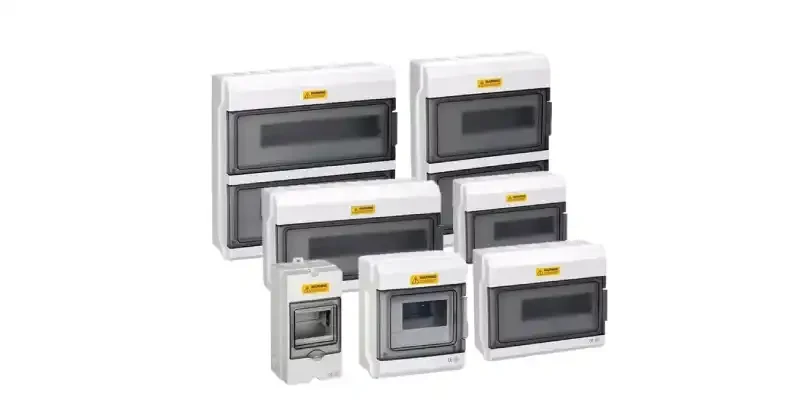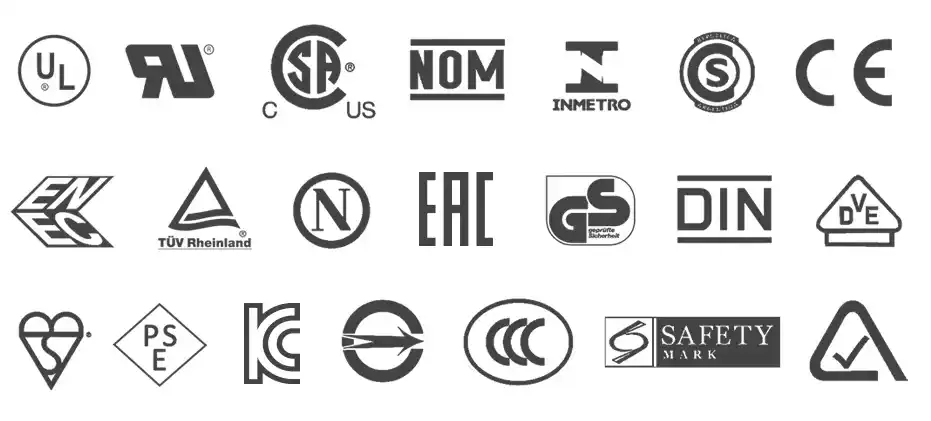Distribution Box Selection Guide
This guide provides information on how to select the appropriate Distribution Box for Electric project. If you have any questions about distribution boxes, please feel free to contact us.
What is needed for Distribution box
A distribution box, sometimes referred to as a panel board, distribution board, or breaker panel, is an essential part of electrical systems that makes it easier to distribute electricity throughout a structure. Dividing incoming electrical power from the main supply into subsidiary circuits is the principal purpose of a distribution box. It contains a number of safety mechanisms, including fuses and circuit breakers, which aid in preventing overloads and short circuits. This electrical distribution center makes sure that power outlets and illumination are safely connected to various locations.
Components of a Distribution Board
For controlling and allocating electrical power inside a structure, a distribution board—also referred to as a breaker panel or electrical panel—is essential. It acts as the primary hub via which several circuits are connected to the main supply of electricity. The following are the main elements of a distribution board:
1. Bus Bars
Distributing power within the panel are bus bars, which are conductive metal strips usually composed of copper or aluminum. Establishing a connection between the main circuit breaker and several outbound circuits, they serve as the foundation of the distribution board.
2. Circuit Breakers
Circuit breakers are crucial safety components that guard against overloads and short circuits in electrical circuits. When an excessive amount of current passes through them, they immediately cut off the power supply to avoid possible harm to the electrical system. Depending on the need, circuit breakers can be single- or double-pole.
3. Residual Current Devices (RCDs)
RCDs keep an eye on a circuit’s electrical flow and cut it off if they notice an imbalance that might be a sign of a current leak. In both home and commercial installations, this function is essential for preventing electric shocks and guaranteeing safety.
4. Fuses
Fuses are safety devices that break the circuit when an excessive amount of current passes through them. If a fuse blows, it needs to be replaced, unlike circuit breakers. Although they are less frequent in contemporary panels, they are nevertheless employed in several situations.
5. Surge Protection Devices (SPDs)
SPDs guard against surges or lightning-related voltage spikes that could harm electrical equipment. They assist in preventing delicate electronics attached to the distribution board from being harmed.
6. Main Circuit Breaker
The main circuit breaker serves as the major electrical system safety device. In the event of an overload or fault, it cuts off power to all linked circuits by disconnecting the main supply.
7. Isolators and Disconnect Switches
These switches provide the safe isolation of circuits for emergency situations or maintenance. They guarantee that de-energizing some parts of the electrical system won’t harm others.
8. Neutral and Ground Bars
By offering specific connections for neutral and ground wires, these bars guarantee that electrical currents in the system are properly grounded and have return pathways.
9. Bypass Equipment
Bypass equipment enables circuit testing or repair without affecting other electrical system components.
How do I choose the right electrical distribution board for home
Assess Your Electrical Needs
Begin by carefully evaluating the electrical needs of your property. Make a thorough inventory of every appliance, light fixture, and gadget that will be connected to the DB board. Remember to factor in possible future additions to prevent underestimating your requirements. Consider prospective home office configurations, new equipment, and impending renovations that could raise your electrical use.
Consult with a Professional Electrician
Hire a licensed electrician as soon as possible in the procedure. When it comes to choosing the right DB board size and configuration, their knowledge is vital. They are able to guarantee adherence to all pertinent safety regulations and carry out precise load calculations. You can make sure your electrical system is safe and effective by following the advise of an electrician and avoiding expensive blunders.
Research Different Brands and Models
Examine the many models and brands that are on the market. Examine user feedback and specifications to identify a DB board that fits your needs. A few things to look for are build quality, installation simplicity, and post-purchase assistance. At VIOX Electric, we provide a selection of premium DB boards that are ideal for a number of home applications and are made to the highest safety requirements.
Consider Your Budget
Costs should be taken into account, but keep in mind that your electrical distribution board is an investment in the long run that will improve the functionality and safety of your house. Strive for a balance between quality and price. Take into account long-term aspects like energy efficiency and maintenance needs in addition to the purchase price. Occasionally, spending more money up front on a higher-quality board can save money over time by increasing efficiency and requiring less upkeep.efficiency and performance.
Installation and Testing
Make sure an electrician with a license installs the DB board you’ve chosen. Expert installation is essential for both effectiveness and safety. To ensure correct operation, a thorough testing procedure should be followed, which should include inspections for load distribution, circuit breaker action, and grounding. Plan routine maintenance inspections after installation to keep your distribution board in excellent shape and spot possible problems early.
Factors to Consider When Choosing a Distribution box
Type of Property
The nature of your property plays a crucial role in determining the appropriate Distribution Box. Different settings have distinct electrical requirements:
- Residential: Homes typically require single-phase power and a Distribution Box with fewer circuits. These boxes are compact and suitable for managing household appliances and lighting.
- Commercial: Business premises often need three-phase power and more complex Distribution Boxes. These can handle a higher number of circuits and greater electrical loads, catering to equipment, lighting, and HVAC systems.
Number of Circuits
Carefully assess the number of circuits your property needs. This includes:
- Lighting circuits
- Power points
- HVAC systems
- Specialized circuits for large appliances or machinery
Remember to plan not just for current needs but also potential future expansions. It’s often more cost-effective to install a slightly larger box initially than to upgrade later.
Load Capacity
When designing or upgrading a residential distribution board, it’s crucial to accurately calculate the total electrical load. This ensures the board can safely handle the combined load of all connected circuits. Here’s a typical load calculation example for a 1,500 square foot home:
The calculation begins by listing the major electrical items in the home, including general lighting and receptacles, small appliance circuits, laundry circuit, gas furnace, microwave oven, and a new electric water heater. The power consumption (VA) for each item is estimated and listed.
| General Lighting and Receptacles: 1,500 sq. ft. home x 3 VA per sq. ft. | 4,500 VA |
| Small Appliance Circuits: 2 circuits x 1,500 VA | 3,000 VA |
| Laundry Circuit: 1 circuit x 1,500 VA | 1,500 VA |
| Gas Furnace: 1 circuit x 1,500 VA | 1,500 VA |
| Microwave Oven: 1 circuit x 1,500 VA | 1,500 VA |
| New Electric Water Heater: 1 circuit x 3,000 VA | 3,000 VA |
| Subtotal Existing Load | 15,000 VA |
| First 8,000 VA of existing load at 100% | 8,000 VA |
| Remaining existing load at 40% (15,000 VA – 8,000 VA = 7,000 VA) (7,000 VA x 40% = 2,800 VA) | 2,800 VA |
| Total Existing Load | 10,800 VA |
| Convert 10,800 VA to amperes (10,800 VA divided by 240 Volts = 45 Amps) A 100-ampere service is more than adequate for this home | |
Family Handyman – Electrical Load Calculation
Safety Features
Modern DB boards come with various safety features such as Residual Current Devices (RCDs), Surge Protection Devices (SPDs), and Miniature Circuit Breakers (MCBs). These features protect against electrical shocks, surges, and short circuits.
- RCDs: Detect and disconnect power in the event of an earth fault.
- SPDs: Protect against voltage spikes caused by lightning or power surges.
- MCBs: Automatically cut off power during overload or short circuit conditions.
Compliance with Standards
Ensure your chosen Distribution Box adheres to local and international safety standards. For instance, in South Africa, compliance with SANS (South African National Standards) guidelines is mandatory. This compliance ensures the box meets minimum safety and performance requirements.
Ease of Installation and Maintenance
Opt for a Distribution Box designed for straightforward installation and maintenance:
- Look for modular designs that allow easy expansion
- Choose boxes with clear labeling for quick identification of circuits
- Consider accessibility for future repairs or upgrades
Installation guide
For those looking to install a distribution board or wire a single-phase house, we’ve provided two instructional videos to guide you through the process:
- How to Install a Distribution Board on the Wall
This video provides a step-by-step guide on properly mounting a distribution board to a wall. It covers essential aspects such as choosing the right location, securing the board, and ensuring it’s level and stable.
- How to Wire a Single Phase House Wiring Diagram
This tutorial walks you through the process of wiring a single-phase house. It explains the wiring diagram, showing how to connect various circuits and components in a residential electrical system.
Conclusion
Selecting the right distribution box is crucial for ensuring the safety, efficiency, and reliability of your electrical system. By considering factors such as your property type, the number of circuits required, load capacity, safety features, and compliance with standards, you can make an informed decision. Remember to consult with a professional electrician, plan for future needs, and prioritize quality and safety over cost. Proper installation and regular maintenance are equally important to maximize the longevity and performance of your distribution box. With careful consideration and expert guidance, you can create an electrical system that meets your current needs and is prepared for future demands.




